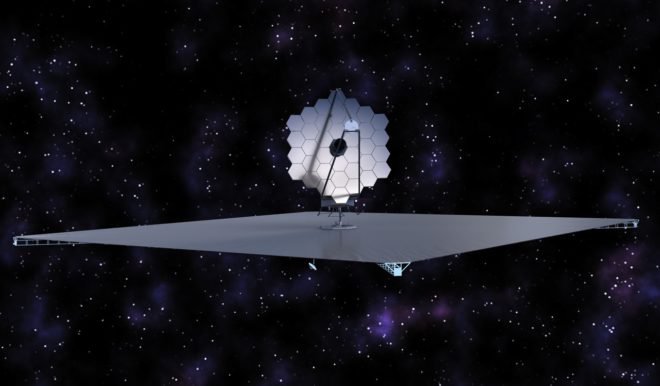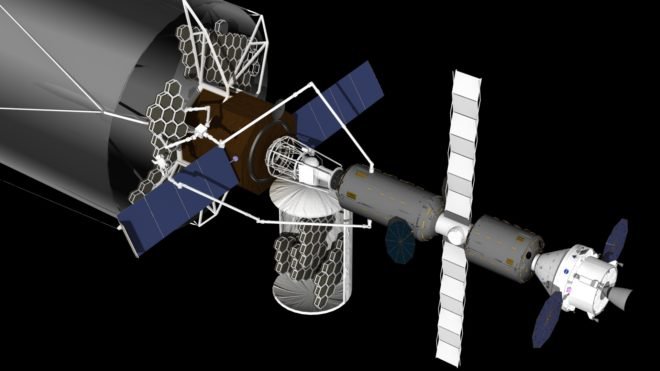
March 16, 2017
Feature Story
A Vision That Could Supercharge NASA

An artist rendering of an approximately 16-meter telescope in space. This image was created for an earlier large space telescope feasibility project called ATLAST, but it is similar to what is being discussed inside and outside of NASA as a possible great observatory after the James Webb Space Telescope and the Wide-Field Infrared Survey Telescope. Advocates say such a large space telescope would revolutionize the search for life on exoplanets, as well as providing the greatest observing ever for general astrophysics. (NASA)
Let your mind wander for a moment and let it land on the most exciting and meaningful NASA mission that you can imagine. An undertaking, perhaps, that would send astronauts into deep space, that would require enormous technological innovation, and that would have ever-lasting science returns.
Many will no doubt think of Mars and the dream of sending astronauts there to explore. Others might imagine setting up a colony on that planet, or perhaps in the nearer term establishing a human colony on the moon. And now that we know there’s a rocky exoplanet orbiting Proxima Centauri — the star closest to our sun — it’s tempting to wish for a major robotic or, someday, human mission headed there to search for life.
All are dream-worthy space projects for sure. But some visionary scientists (and most especially one well-known former astronaut) have been working for some time on another potential grand endeavor — one that you probably have not heard or thought about, yet might be the most compelling and achievable of them all.
It would return astronauts to deep space and it would have them doing the kind of very difficult but essential work needed for space exploration in the far future. It would use the very costly and very powerful Space Launch System (SLS) rocket and Orion capsule being built now by NASA and Lockheed Martin respectively. Most important, it would almost certainly revolutionize our understanding of the cosmos near and far.
At a recent meeting of the House Science Committee, chairman Lamar Smith, said of the hearing’s purpose that, “Presidential transitions offer the opportunities to reinvigorate national goals. They bring fresh perspectives and new ideas that energize our efforts.”
That said, here’s the seemingly feasible project that fires my imagination the most.
It has been quietly but with persistence promoted most visibly by John Grunsfeld, the former astronaut who flew to the Hubble Space Telescope three times to fix and upgrade it, who has spent 58 hours on spacewalks outside the Shuttle, and towards the end of his 40 years with the agency ultimately became an associate administrator and head of the agency’s Science Mission Directorate.

A visualization of the assembly in space of a large segmented telescope, with work being done by astronauts and robots. The honeycomb blocks are parts of the mirror, and the grey cylinders on the right are habitats for astronauts. (NASA)
His plan: Build a segmented space telescope mirror that is 16 meters (52 feet) in diameter or larger, package it into one or several payload fairings and launch it into deep space. Accompanying astronauts would put it together either at its final destination or at a closer point where it could then be propelled to that destination.
This would provide invaluable humans-in-space experience, would put the Orion and SLS to very good use in advance of a projected human mission to Mars, and would deploy the most penetrating telescope observing ever. By far.
No mirror with a diameter greater than 3.5 meters (11.5 feet) has ever been deployed in space, although the the James Webb Space Telescope mirror will be substantially larger at 6.5 meters (21 feet) when launched in 2018. The largest ground telescopes are in the 10-meter (33 foot) range.
What Grunsfeld’s space behemoth would provide is an unprecedented power and resolution to see back to the earliest point possible in the history of the universe, and doing that in the ultraviolet and visible wavelengths. But perhaps more significantly and revolutionary, it would supercharge the agency’s ability to search for life beyond Earth.
Like nothing else currently in use or development, it would provide a real chance to answer what is arguably humanity’s most fundamental question: Are we alone in the universe?